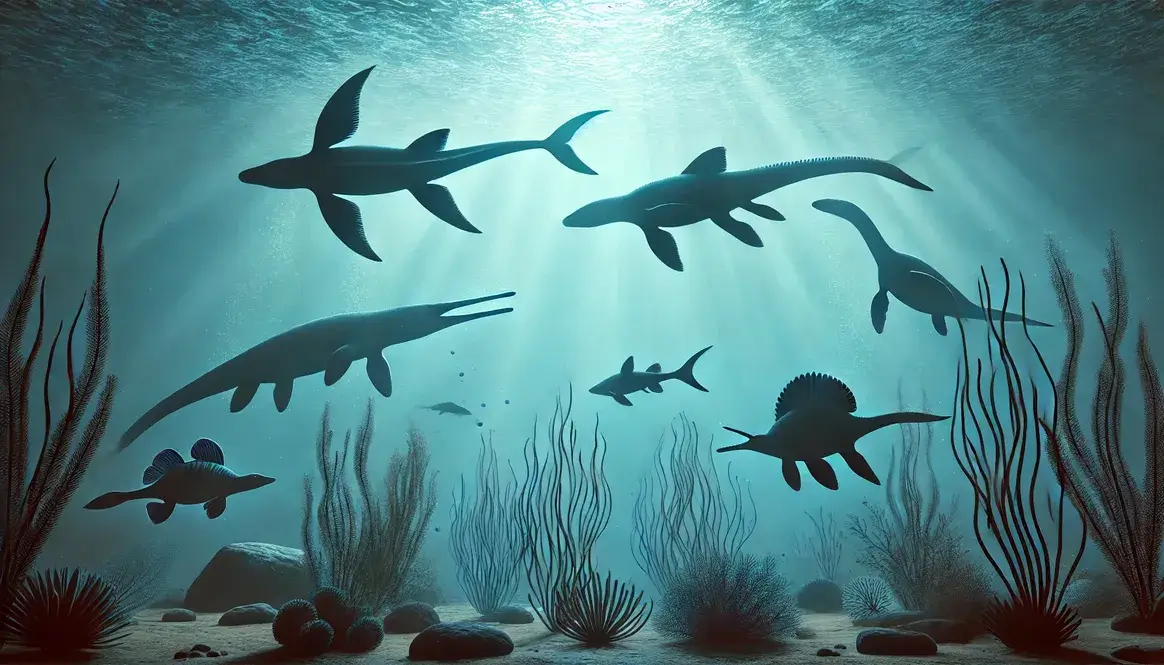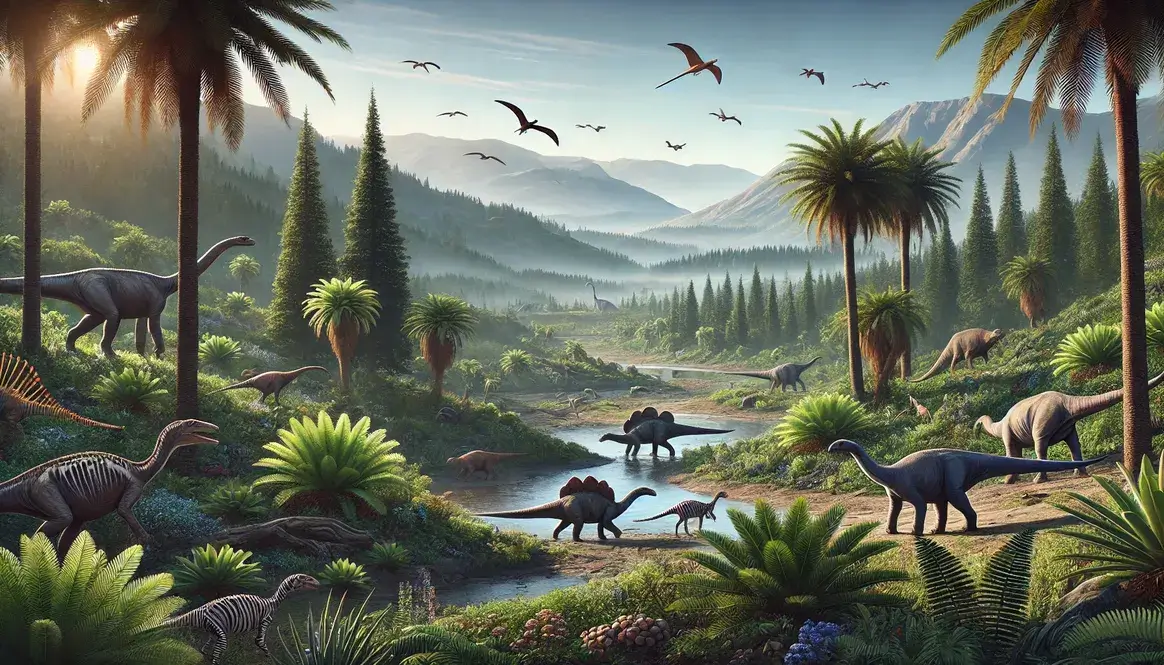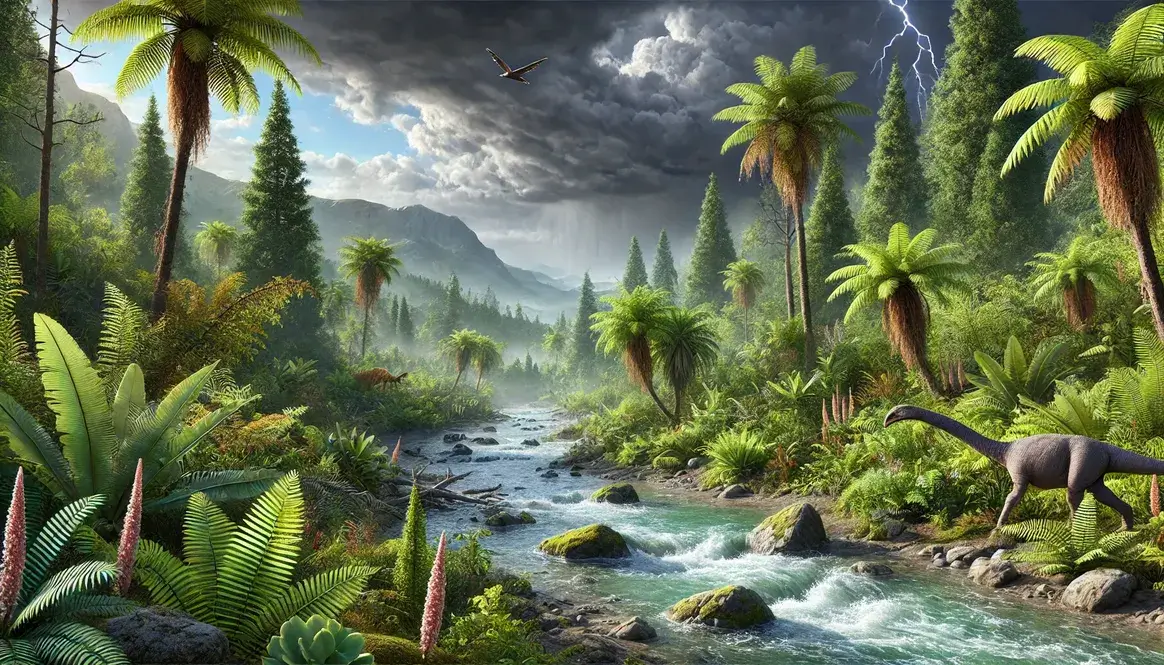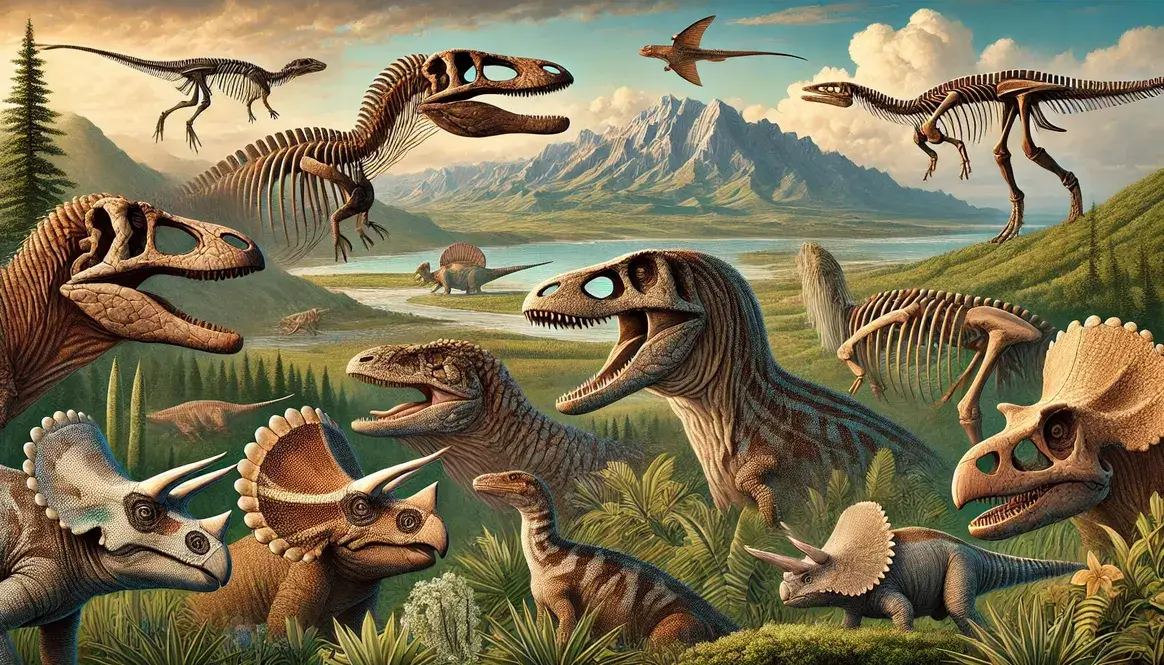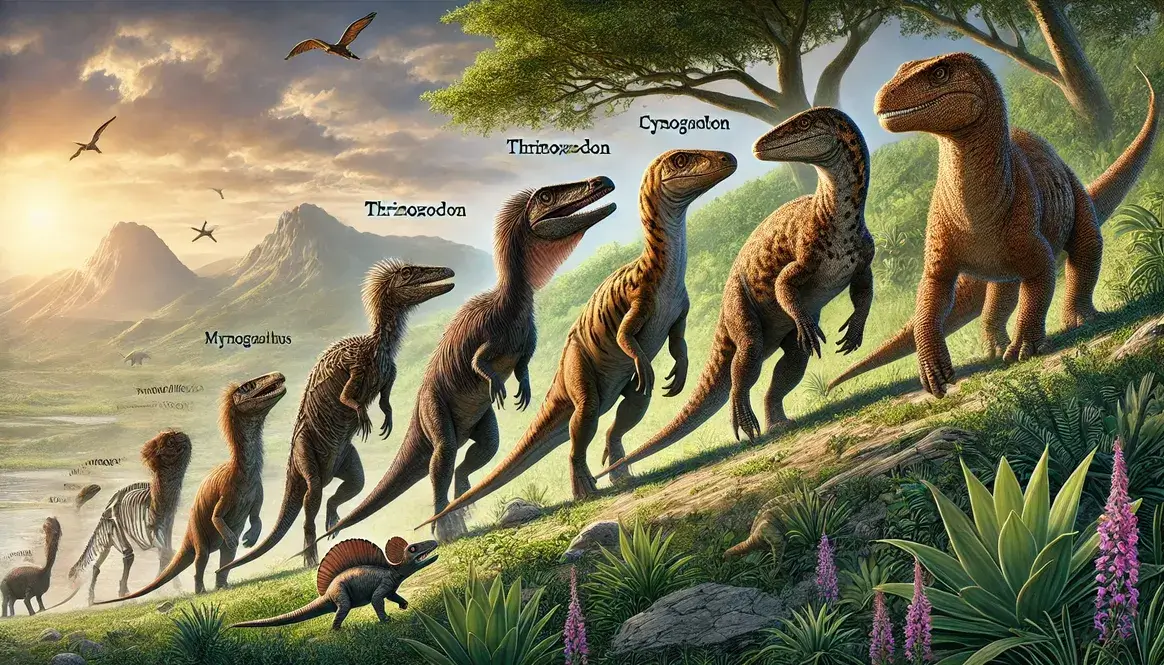Have you ever wondered what swam in the oceans when dinosaurs first appeared on land? Let’s dive into the fascinating world of Triassic sea creatures! These ancient marine animals ruled the waves long before sharks became the oceans’ top predators.
The Triassic Seas: A New Chapter for Marine Life
The Triassic period, spanning from about 252 to 201 million years ago, marked a turning point for life on Earth. After the devastating Permian-Triassic extinction event, which wiped out nearly 95% of marine species, the oceans were ready for a fresh start.
During this time, the supercontinent Pangaea dominated the globe, surrounded by a vast ocean called Panthalassa. As the climate warmed and sea levels rose, new marine ecosystems emerged, setting the stage for an explosion of marine reptile diversity.
The major groups of Triassic sea creatures that ruled these ancient waters included ichthyosaurs, plesiosaurs, nothosaurs, and placodonts. Each of these groups played a unique role in the Triassic marine ecosystems, filling niches left empty by the extinction and evolving remarkable adaptations for life in the water.
Major Marine Reptile Groups of the Triassic
The Triassic seas were home to an incredible cast of characters, each with their own unique adaptations and lifestyles. Let’s dive deeper into these fascinating groups of Triassic sea creatures!
Ichthyosaurs: The Fish-Shaped Reptiles
Ichthyosaurs were among the most successful marine reptiles of the Triassic. Their name means “fish lizard,” and it’s easy to see why!
Key characteristics of ichthyosaurs:
- Streamlined, dolphin-like body shape
- Powerful tail flukes for swimming
- Large eyes for hunting in deep or murky waters
- Nostrils located near the eyes for easier breathing at the surface
One notable ichthyosaur species from the Triassic was Shonisaurus, which could grow up to 15 meters (49 feet) long – about the size of a modern sperm whale!
Ichthyosaurs evolved some amazing adaptations for marine life. For example, their flippers contained many small bones, allowing for better maneuverability in water. They also developed a tail fluke shaped like a half-moon, similar to modern sharks, which provided powerful propulsion through the water.
Early Plesiosaurs: Long-Necked Marine Predators
While not as common in the Triassic as they would become in later periods, the first plesiosaurs began to appear towards the end of this era.
Distinguishing features of early plesiosaurs:
- Long necks (though not as extreme as later species)
- Four paddle-like limbs
- Small heads with sharp teeth
Early plesiosaurs were likely ambush predators, using their long necks to strike at unsuspecting fish and squid. Unlike ichthyosaurs, which swam like fish, plesiosaurs used their four flippers to “fly” through the water, similar to how sea turtles swim today.
Compared to ichthyosaurs, early plesiosaurs were generally slower swimmers but potentially more maneuverable in shallow waters.
Nothosaurs: Ancestors of the Plesiosaurs
Nothosaurs were semi-aquatic reptiles that are thought to be closely related to the ancestors of plesiosaurs.
Nothosaur characteristics:
- Long, slender bodies
- Webbed feet for swimming
- Long necks and tails
- Sharp teeth for catching fish
Nothosaurs likely lived in coastal areas, able to move on land but spending most of their time in the water. They played a crucial role in the evolution of marine reptiles, representing a transitional form between land-dwelling reptiles and fully aquatic plesiosaurs.
Unlike plesiosaurs, nothosaurs retained the ability to move on land, though they were probably clumsy out of water – think of how seals move on land today!
Placodonts: The Shell-Crushing Specialists
Placodonts were a unique group of marine reptiles that evolved some pretty cool adaptations for a specific diet: shellfish!
Unique features of placodonts:
- Flat, rounded teeth perfect for crushing shells
- Heavy, armored bodies in some species
- Paddle-like limbs for swimming
Placodonts came in various shapes and sizes. Some, like Placodus, looked a bit like a stocky marine iguana. Others, such as Henodus, had shells that made them look like aquatic turtles (even though they weren’t closely related to turtles at all).
These shell-crushing specialists played an important role in Triassic marine ecosystems. They kept populations of shelled creatures in check and likely helped to shape the evolution of their prey’s defensive structures.
Evolution of Ichthyosaurs and Plesiosaurs
The story of how reptiles returned to the sea is a fascinating tale of adaptation and opportunity. After the Permian-Triassic extinction event, the oceans were ripe for colonization, and some enterprising reptiles took the plunge.
From Land to Sea: The Origin of Marine Reptiles
Scientists believe that both ichthyosaurs and plesiosaurs evolved from different groups of land-dwelling reptiles. Here’s a quick rundown of the current theories:
- Ichthyosaurs: Likely evolved from a group of diapsid reptiles, possibly related to archosaurs (the group that includes dinosaurs and their ancestors).
- Plesiosaurs: Thought to have evolved from a group called sauropterygians, which includes nothosaurs.
The transition from land to sea didn’t happen overnight. It took millions of years and involved many changes, including:
- Development of more streamlined bodies
- Evolution of limbs into flippers
- Changes in bone density and structure
- Adaptations for giving birth in water
Ichthyosaur Evolution in the Triassic
Early ichthyosaurs looked quite different from their later relatives. Let’s look at how they changed over time:
Early Triassic ichthyosaurs:
- More elongated, eel-like bodies
- Downward-pointing tails
- Less specialized flippers
Late Triassic ichthyosaurs:
- More fish-like body shape
- Crescent-shaped tail flukes
- Highly adapted flippers for steering and propulsion
One of the earliest known ichthyosaurs, Cartorhynchus, still had features that allowed it to walk on land. By the Late Triassic, ichthyosaurs like Shonisaurus were fully adapted to life in the open ocean.
The Emergence of Plesiosaurs
Plesiosaurs made their debut later in the Triassic, evolving from nothosaur-like ancestors. Their evolution was marked by several trends:
- Neck elongation: Early plesiosaurs had longer necks than their ancestors, but not as extreme as later species.
- Limb modification: The transition from webbed feet to paddle-like flippers.
- Skull changes: The skull became more streamlined, with a longer snout filled with sharp teeth.
By the end of the Triassic, early plesiosaurs like Plesiosaurus had emerged, setting the stage for the diverse group of long-necked marine reptiles that would dominate the seas in the Jurassic period.
As we can see, the Triassic was a time of incredible evolutionary innovation in the seas. These marine reptiles paved the way for even more diverse and specialized forms in the following periods, shaping the course of marine life for millions of years to come.
Unique Adaptations to Marine Life
The Triassic sea creatures developed some truly remarkable adaptations to thrive in their aquatic environment. These changes revolutionized their bodies, allowing them to become masters of the ancient oceans.
Body Shape and Locomotion
One of the most striking adaptations of Triassic marine reptiles was their streamlined body shape, perfect for cutting through water with minimal resistance.
Ichthyosaurs took this to the extreme. Over time, their bodies became more fish-like, with a torpedo-shaped form that would make modern dolphins jealous. Their tails evolved into powerful, crescent-shaped flukes, providing strong propulsion. Ichthyosaur fins also changed dramatically, becoming more like flippers, with many small bones allowing for precise control in the water.
Plesiosaurs, on the other hand, developed a unique form of underwater “flight.” Their four paddle-like limbs moved in a figure-eight pattern, similar to how sea turtles swim today. This method allowed them to maneuver gracefully in the water, despite their long necks and bulky bodies.
Breathing and Diving Adaptations
Breathing underwater is tricky business, but Triassic sea creatures figured it out in style.
Ichthyosaurs evolved nostrils that migrated to the top of their heads, much like modern whales. This allowed them to take quick breaths at the surface without fully lifting their heads out of the water. Talk about efficiency!
Both ichthyosaurs and plesiosaurs likely had adaptations for deep diving and long submergence. Scientists think they may have had:
- Collapsible lungs to withstand pressure changes
- The ability to store oxygen in their muscles (like modern whales)
- Slowed heart rates to conserve oxygen during dives
These adaptations would have allowed them to hunt in deeper waters, accessing food sources that shallow-water predators couldn’t reach.
Sensory Adaptations
To navigate and hunt in the sometimes murky Triassic seas, these reptiles needed top-notch senses.
Ichthyosaurs developed enormous eyes – some of the largest relative to body size of any known animal! These massive peepers would have been excellent for spotting prey in low-light conditions, giving ichthyosaurs a real advantage in deeper waters.
As for plesiosaurs, their sensory capabilities are still a bit of a mystery. Some scientists think they might have had electroreceptive organs, similar to those in sharks, to detect the tiny electrical fields produced by their prey. Others suggest they might have used their long necks like antenna, sensing water movements to locate fish.
Reproduction and Birth
Perhaps one of the most fascinating adaptations of these marine reptiles was their method of reproduction.
We have solid evidence that ichthyosaurs gave birth to live young. Fossils have been found of ichthyosaur mothers with babies inside them or in the process of being born. This was a crucial adaptation, as it meant they never had to return to land to lay eggs.
For plesiosaurs, the evidence is less clear. However, given their body shape and fully marine lifestyle, many scientists believe they also gave birth to live young. Some even suggest they might have cared for their offspring, similar to modern whales or dolphins.
Important Triassic Marine Fossil Discoveries
The fossils of Triassic sea creatures have provided us with incredible insights into these ancient marine ecosystems. Let’s explore some of the most significant finds!
Ichthyosaur Fossils: Windows to the Past
Ichthyosaur fossils have been found all over the world, giving us a global picture of these amazing creatures.
Notable ichthyosaur fossil sites include:
- The Alps in Europe, where some of the earliest ichthyosaur fossils were discovered
- Nevada in the United States, home to the enormous Shonisaurus fossils
- China, where exceptionally well-preserved ichthyosaur fossils have been found
One particularly exciting discovery was a fossil of an ichthyosaur mother in the process of giving birth. This fossil provided definitive proof that ichthyosaurs gave birth to live young, rather than laying eggs like their land-dwelling ancestors.
Plesiosaur and Nothosaur Discoveries
While not as common as ichthyosaur fossils, plesiosaur and nothosaur discoveries have greatly expanded our understanding of these groups.
Significant finds include:
- Early plesiosaur fossils from England, which helped establish the link between nothosaurs and plesiosaurs
- Well-preserved nothosaur fossils from China, providing detailed information about their anatomy
- Fossils from Germany that show the transition from semi-aquatic nothosaurs to fully aquatic plesiosaurs
These fossils have allowed paleontologists to piece together the evolutionary history of these fascinating creatures, showing how they adapted to life in the Triassic seas.
Placodont Fossils: Piecing Together the Puzzle
Placodont fossils, while less common than those of ichthyosaurs or plesiosaurs, have provided valuable insights into the diversity of Triassic marine life.
Key placodont discoveries include:
- Fossils of Placodus from Germany, revealing its unique crushing teeth
- The shell-like armor of Henodus, found in southern Germany
- Placodont fossils from China, expanding our understanding of their global distribution
These fossils have shown us the incredible variety of adaptations that evolved in the Triassic seas, from shell-crushing teeth to turtle-like armor.
The Legacy of Triassic Sea Creatures
The impact of Triassic sea creatures on subsequent marine ecosystems can’t be overstated. They set the stage for the marine reptile dynasties that would dominate the oceans for millions of years to come.
Ichthyosaurs, plesiosaurs, and their relatives filled crucial ecological niches, becoming top predators and important members of marine food webs. Their presence likely influenced the evolution of fish, squid, and other marine life, driving the development of new defensive and predatory adaptations.
Moreover, studying these ancient marine reptiles has been crucial in understanding the evolution of marine reptiles as a whole. They provide a fascinating example of how land-dwelling animals can return to the sea, evolving remarkable adaptations in the process.
The story of Triassic sea creatures reminds us that life on Earth is constantly changing and adapting. As we continue to study these ancient marine ecosystems, we gain valuable insights into the Earth’s history during the Triassic period and the incredible diversity of life that has existed on our planet.
Discover more about the Triassic Period and its fascinating creatures to further explore this captivating era of Earth’s history.

